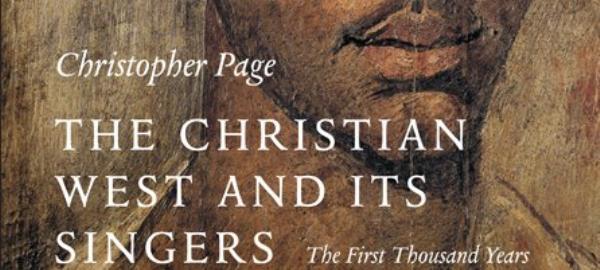This is a splendid volume. Dr Christopher Page is Reader in Medieval Literature and Musicology with over twenty years’ teaching experience. He is also a professional musician, the founder-director of the vocal ensemble Gothic Voices. The result of such a blend of scholarship is a book with enormous breadth of coverage. Dr Page has researched original sources, many of them newly available. As a result he has been able to paint a much fuller picture of the growth of music in the Christian West than hitherto available or even attempted.
Dr Page describes to us not only who were the singers of Western Christianity, but also what was their social, cultural and religious milieu – and therefore why they sang in the way that they did. We learn how the early lectors were also cantors, for the psalms needed to be ‘cantillated’. But we also discover how Roman trade formed the communications routes which account for the closeness of the Church in North Africa to the Church in Rome. We read about the household churches, necessary before Constantine, resulting in the little-known ministry of urban house-ascetics, forerunners of the monastic tradition. In the absence of documentation about the liturgy in Rome in the fifth and sixth centuries, we are taken on a tour of cathedrals and churches in other parts of the former Roman Empire. We learn of the rise of scholae cantorum, specialist groups of singers who began the tradition of Gregorian chant as we know it, and of the spreading of the tradition to France in the eighth century at the behest of Pepin (or Pippin, as Dr Page calls him, no doubt correctly). Then we recall his Carolingian successors, whose conquest of Europe progressively spread the chant. As new local saints were declared and venerated, so new chant was written for the new texts, and then rewritten by succeeding generations – although little of such local usage can be found in chant books available today. We read of how the monks managed to commit to memory and transmit the Gregorian repertoire without having any means of writing down its music until the ninth century. Readable musical notation only begins as neums in the tenth century and staff notation with Guido d’Arezzo only in the eleventh. Only since Guido have we been able to pick up a piece of music and read it at sight.
The attraction of this book is that it describes people, real flesh and blood, rather than the dustiness of manuscripts and tombstones, though the author has pored over and examined more than enough of these. We have a full list of those who gathered for a Eucharist at Abitina in North Africa in February 304, and what they sang before they were marched off to be martyred. Much later, we read of the trials of Rudolf of Sint Truiden, an abbey now in Belgium, as an adolescent cantor and eventually its abbot in the twelfth century. But there are some dramatis personae missing, no doubt for want of documentation. How did Benedictine monks sing in their monasteries, given that St Benedict had specified very precisely in his Rule what was to be their ordo psallendi, which was different from Roman practice? Given the rarity and preciousness of manuscripts, how much singing had perforce to be entrusted to a soloist and how much to the rank-and-file monks? Psalm-singing undoubtedly took various forms; Dr Page modestly disclaims expertise in liturgy and chant, so we are spared the complexities of the development of antiphons.
We know that the corpus of Gregorian chant for the Proper of the Mass was established by the Roman scholae cantorum before the year 700. In the second half of the succeeding century, it was imported into France with the aid of Roman cantors who made the journey for the specific purpose of teaching their Frankish counterparts. The resulting Frankish-Roman chant then spread all over the Carolingian empire. But how much was it Roman and how much Frankish? To what extent did it reflect the earlier Gallican liturgy which was replaced (more or less) by the Roman? Were only the success stories of Romanisation recorded, while Gallic obstinacy persisted elsewhere? For all the virtual unanimity of manuscripts surviving from such mutually distant sources as St Gall in Switzerland and Laon in northern France, how uniform was the chant over the span of the Carolingian empire? Dr Page leads us on an intriguing detective trail for which lack of musical notation frustratingly denies us a solution. The question is important because the oldest Gregorian chant in our Gradualia and Antiphonalia today is precisely that Frankish-Roman chant handed down by the manuscripts of St Gall, Laon and elsewhere. The latest editions now being published by the Solesmes congregation, shorn of the now discredited ‘Solesmes rhythmical signs’, are as faithful as they can be to the earliest scripts, but there are still many questions as to how the chant originally sounded – let alone how it might sound and serve the liturgy a millennium later.
The volume is beautifully printed on art paper throughout, and at 5 lbs (2.2 kg) weight is much heavier than a volume of the Encyclopaedia Britannica. At £30 it is very good value for money.
The reviewer, John Ainslie, is a member of the Music Committee for the Diocese of Westminster.






